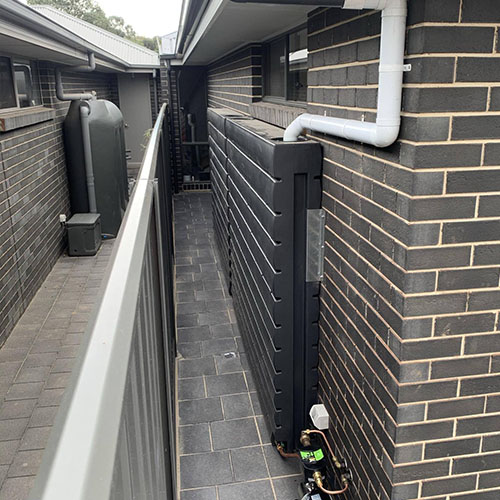Slimline Water Tanks: Space-Saving Solutions for Little Qualities
Slimline Water Tanks: Space-Saving Solutions for Little Qualities
Blog Article
Recognizing the Importance of Rainwater Containers in Drought-Prone Regions for Water Security
In regions susceptible to extended droughts, the duty of rainwater containers in boosting water safety and security is a subject of growing importance. As neighborhoods grapple with the obstacles of water scarcity, recognizing the relevance of these tanks exceeds plain collection of rainwater. Rain tanks act as an important device in alleviating the impact of water scarcities by offering a lasting source of water for numerous needs. Nonetheless, the true worth of rainwater containers prolongs far past mere storage space; it incorporates resilience-building steps and the promo of long-lasting water conservation methods. This multifaceted technique to water security warrants a more detailed evaluation of the duty rainwater storage tanks play in ensuring a trusted water system during times of drought.
Advantages of Rain Containers
Utilizing rainwater containers supplies a lasting option for increasing water supply and improving water safety and security in domestic and commercial setups. One of the main benefits of rainwater containers is their capacity to lower reliance on mains water supply.

Rain Harvesting Techniques
Rainwater collecting strategies incorporate a variety of approaches created to effectively gather and keep rainwater for various purposes, contributing to water preservation and sustainability. One usual method is the setup of rooftop catchment systems, where rainwater is collected from the roof of a building and routed to a storage space container. This technique is relatively simple and cost-effective. Another preferred strategy is the usage of above-ground or below ground storage space containers to save rain for later usage. These storage tanks are available in various dimensions and products to fit different needs and can be connected to the existing pipes system for very easy accessibility.

Additionally, rainfall gardens and absorptive sidewalks are innovative strategies that involve landscape design or paving surface areas in a way that enables rain to percolate into the ground, renewing groundwater gets. Additionally, shape farming and terracing are farming methods that aid capture rain and prevent dirt disintegration in hilly terrain. By applying these diverse rainwater harvesting methods, neighborhoods can boost water security and durability in drought-prone areas while advertising sustainable water administration methods.
Relevance of Water Security
Making sure reliable access to clean and sufficient water resources is vital for maintaining human health and wellness, financial growth, and environmental well-being. Water safety is an essential facet of societal resilience, particularly in regions susceptible to droughts and water shortage. Appropriate water safety includes different measurements, including availability, quality, and ease of access of water for domestic, agricultural, commercial, and ecological demands.
Water safety plays a vital function in advertising public wellness by lowering the frequency of waterborne conditions and making sure hygiene facilities. Economically, water protection is crucial for farming productivity, commercial procedures, and overall economic development. Slimline water tanks. Water protection is carefully linked to ecological sustainability, as it sustains moved here communities, biodiversity, and general ecological balance.
In drought-prone areas, water protection comes to be a lot more important as a result of the increased danger of water shortages. Carrying out approaches like rainwater harvesting, water recycling, and efficient water management practices can dramatically improve water security in these areas. By prioritizing water safety and security, communities can much better withstand the impacts of environment change, populace development, and other difficulties that endanger water schedule.
Enhancing Water Resilience
With boosting international water challenges, developing durability in water supply has actually become a critical focus for sustainable advancement initiatives. Enhancing water resilience involves carrying out strategies to guarantee water accessibility and top quality despite changing environmental conditions, such as droughts, floodings, and pollution.
One key element of boosting water strength is advertising using rainwater storage tanks in drought-prone areas - Slimline water tanks. Rainwater storage tanks offer as a reliable methods of capturing and saving rain for later usage, reducing reliance on scarce freshwater sources during dry periods. By integrating rain harvesting systems right into water management plans, neighborhoods can improve their capability to stand up to water deficiency and maintain water protection

Lasting Water Conservation
Amidst intensifying water challenges, click reference the prudent administration of water sources through sustainable conservation methods is essential for making sure long-lasting ecological security and social well-being. Sustainable water conservation entails the effective usage of water sources to fulfill existing needs without compromising the capability of future generations to satisfy their own demands. By carrying out methods such as rain harvesting, greywater recycling, and water-efficient innovations, areas can lower water wastefulness and alleviate pressure on freshwater sources.
Additionally, sustainable water conservation practices add to ecosystem health by keeping ample water degrees in rivers, lakes, and marshes, sustaining biodiversity, and protecting all-natural habitats. These practices also play an important duty in minimizing the influences of environment modification by assisting to adapt to changing precipitation patterns and water schedule.

Verdict
Finally, rain tanks play a vital role in improving water protection and resilience in drought-prone areas. By visit site making use of rainwater harvesting methods, areas can lower their reliance on standard water resources and advertise sustainable water conservation methods. This not just aids mitigate the effects of water shortage throughout dry spells but likewise contributes to lasting water safety and durability when faced with climate modification obstacles.
Report this page